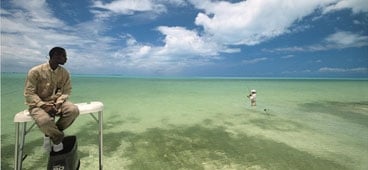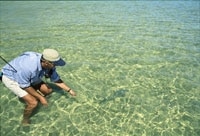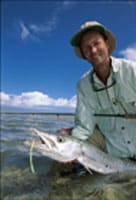
Smack in the middle main page
It all began ominously. As I stood on the bow of the skiff trying to tie on a fly, I noticed a subtle gray shape move into the periphery of my vision. Like any anxious angler, I had to look even though I assumed it was just a barracuda. I was wrong. It was a massive bonefish, about two rod lengths away from our boat, and there I was, totally unprepared. I looked at Alvin Green, our guide, who had also noticed the monster bone (a fish of at least 12 pounds), and calmly said, “Al, I thought you were supposed to keep those things away from me until I was ready.” He just laughed and said, “Yeah, mon, sorry ’bout dat. I’ll try to keep us off ‘im so you kin cas’ at ‘im when you’re ready.”
The sight of a giant bone that close did nothing for my knot-tying abilities, and after what felt like three hours I finally managed to attach the fly to my tippet. Green, true to his word, kept us off the fish without spooking it, although it continued on its course directly away from us and into deeper water. I never got a shot. But that was the first bone we encountered along the famed Middle Bight of Andros, not 10 minutes from the dock at the Mangrove Cay Club. It wasn’t even close to the last one we’d see.
**Location Is Everything
****Everyone has heard the old real estate broker’s adage that the three most important aspects to any property are location, location, location. This is definitely true for the Mangrove Cay Club, which occupies an ideal spot right on the southern side of the mouth of Andros’ Middle Bight. It sits just minutes away from Moxey Town and the local airstrip, and you can actually see some incredibly productive bonefish flats from its dock. This vantage point allows anglers easy access to both the west and east sides of the island and to miles of mangrove-lined flats in between.
While Andros is often viewed as one big island, it’s actually a mass of smaller islands covered with mangroves and divided into segments by countless natural channels and canals. The Middle Bight is basically a warren of flats and mangroves that bisect the island.

| This maze of shorelines and cuts provides literally hundreds of miles of fishable water, as well as easy access to the west side of Andros. It even offers shelter no matter what direction the wind blows.|
Best of all, the water holds a bounty of bones, from countless fish in the 3- to 5-pound range to numerous larger ones – including double-digit fish – especially in the winter months. If that’s not enough, the west side has resident schools of tarpon in the 40- to 100-pound class, and Mangrove Cay has an excellent permit fishery just around the corner that few people know about. If you want to head all of 5 miles offshore during the summer, you can even tangle with tuna, dolphin, mackerel and jacks. Combine that with the atmosphere of one of the premier bonefish lodges in the Bahamas, the cooking of chef Ike Moore, and the hospitality of Liz and Alton Bain and there is just no way to go wrong. And in case things do go awry and the winds won’t back off, the Bains have even devised a “plan B”: They run guests down to the southern tip of Andros in their 26-foot catamaran and let them cast at bones while wading on the protected flats of the Water Cays.
Once I recovered from the near collision with the monster bone, it didn’t take us long to find plenty of average-sized fish. We encountered schools, singles and doubles continuously and rarely had to wait longer than 10 minutes between shots. When Ken Murph took the bow our first morning, I watched our guide work the waters, and desperately tried to see what he saw. I noticed quickly that Green was pretty laid-back, which is far from what I expected. Not only that, but he quickly sized up Murph’s abilities and mine, and he never called out a fish until he felt it was within range. Several times I watched him track a fish without saying a word until he had positioned the boat so that the fish was right in line for us. Even then, as excited as we knew he was, he would calmly tell us the direction and distance and then add, “Cast if you want to ? “
And when we fouled up the situation, he just laughed and pointed us toward a new school. He worked so diligently to put us on bonefish, without increasing the pressure on us, that when we did mess up a shot, I felt like apologizing. I found out over the next three days that this was not a trait unique to Green. In fact, all the guides here have it. That’s likely because the Bains hand-pick them all, and then head guide Christopher Leadon, who is undoubtedly one of the best – and funniest – guides on the island, trains them. While I have fished with many good guides in the Bahamas, I had never before encountered such a thoroughly professional crew.
By the end of that first day, Murph and I had each caught our fill. As we pulled back up to the club and wandered into the bar, Moore brought out conch fritters and we watched the sun set over the mangroves with the other guests. How could it possibly get any better?
**More Than Bones
** The second day out, Travis Baker and I headed toward the west side with guide Darrin Clark to look for larger bones. It didn’t take long for us to pull up to a likely looking flat, and it took even less time to find the fish. Some were so eager to take the fly that we couldn’t have kept them off it if we’d tried. We both lined and spooked fish only to have them immediately turn around and inhale our flies. It was so silly at times that we just had to laugh.
| While cruising up a beach on the west side of Andros, we ran over a school of fairly large fish we identified as either tarpon or the world’s biggest bonefish. Clark turned off the motor and was poling us along the shore hoping the school would re-form when we noticed a small pod move in from behind us. I had several good shots, but the fish were far too spooked to eat. I asked Clark about the tarpon. There are areas on the western side, he said, where you can almost always find them, and, depending on the tides and the time of year, they are predictable. |

| None are giants, but some triple-digit fish can be found here. We eventually gave up on the tarpon and went looking for the ever-present and eager bones. Once again, we cast to numerous fish and landed over 15.
That night back at the club, Liz mentioned that sharks hang around the docks at certain tides. Because of the property’s proximity to the Tongue of the Ocean, big sharks frequent the docks looking for anything that might be left behind. Since some of these sharks easily reach several hundred pounds, most guests throw baited hooks using heavy spinning rods at the mix of lemon, bull and blacktips. I convinced Moore to give me a few grouper heads for chum and set out to see what I could do with my 12-weight. I attracted a few small sharks, but the winds and tide weren’t quite right, so I didn’t get many shots. But just outside the range of the dock lights, I noticed popping noises – the kind that can only mean something is attacking something else. The best I could do was turn off the lights and literally blind-cast into the darkness. I managed to hook up on my first cast, and although I could tell it wasn’t big, it still fought well. When I finally landed it, I was surprised to see a small horse-eye jack. It turned out to be the only fish worked up enough to attack my popper that night.
**Plan B
** Although the first two days held everything you’d hope for on a fly-fishing trip to the Bahamas, our last day turned out to be less than ideal, with a strong cold front moving in quickly. We discussed our options with Green, including plan B, and decided that we would first try some protected mangroves directly across from Mangrove Cay.
We would give plan B a shot later when the tides would be most conducive. Heading straight across to the northern side of the Middle Bight, we found a resident school of about 200 bonefish and a healthy population of big sharks. Ralph Vitale, my boatmate for the day, told me that on the previous afternoon they had had good luck here, but that the sharks followed them around waiting for them to hook up. Sure enough, the sharks trailed us like hounds on the hunt, and while we didn’t lose any fish during the fight we did lose one after the release. The ruckus prompted us to pick up and try a less-sharky spot. By this time the wind was howling, making it nearly impossible to cast more than about 30 feet effectively. Even so, Green once again managed to put us literally right on top of fish. After catching a few more and getting a little wind worn, we decided to head out onto a flat that’s a bit more protected.
We soon found out the fish were far too shallow for us to pursue in the boat. I hopped out and began wading after them, with Vitale and Green not far behind. With Green’s help we readjusted our vision to pick up on the fish from our diminished angle, but we mostly had to rely on his directions. He led me to two nice bones in a row. Vitale had a few shots as well, but he just couldn’t seal the deal.
We finally called an end to the day with about a half-dozen bones apiece and headed back to try plan B. Once back at the dock, however, we decided not to push our luck – we’d had 2 1/2 great days of fishing and had caught numerous bones. So we sat on the deck behind the club and enjoyed the afternoon. Meantime, everyone else began to work their way back. That evening I realized that this is one fishing destination where being smack in the middle is a huge bonus.
| **How To Get There **Mangrove Cay Club near Moxey Town on Andros is a Shackleton International property, which means that you can book a trip either through Frontiers or one of their affiliates, both of which will take care of almost every detail. Most guests fly through either Fort Lauderdale or Miami to Nassau and then catch a short flight to Andros. Some people like to overnight in Nassau when either coming or going to explore the casinos or beaches, and Frontiers can even arrange private flights and overnight accommodations there. Private charters, set up on your own or through Frontiers, fly you directly into Moxey Town if you prefer to avoid Nassau altogether. | |
| Getting into the Bahamas requires either a passport or a birth certificate, and you have to pay a $15 departure tax, but both processes are quick and easy. Be aware that luggage weight and size are often restricted on the flights between islands in the Bahamas. But the local airlines are used to fly-fishermen and their rod tubes – even longer two-piece cases. Mangrove Cay Club is open from October through June and runs three- to seven-day fishing packages, with a minimum of four days of fishing during the peak season from Mid-March to May. The club even offers a special discounted rate (as much as 20 percent) for stays in the months of January, February and June. Packages are all-inclusive once you get to the lodge, which is immaculate and comfortable and serves outstanding food. The bright atmosphere is inviting and relaxing and will quickly draw you in, and its hospitality extends through every member of the staff. For more information on booking a trip to Mangrove Cay Club, call Travis Baker at Frontiers at 800-245-1950, or log on to www.frontierstravel.com.**What to Bring ** The guides at Mangrove Cay recommend you bring three rods – two bonefish rods and one heavier rod for barracuda, sharks, jacks, tarpon or permit. Depending on your preferences, that should be a 7- or an 8-weight and a 9- or 10-weight, all rigged with weight-forward floating lines. If you go during late fall or winter, remember that you’ll be subject to stronger winds and storms, so you may want to move up a line weight. However, the advantage to fishing during this time of year is that significantly larger bonefish appear much more frequently. While you might choose 10-foot-long leaders with 12-pound tippets, consider using 16-pound tippets instead. It might be overkill on the majority of the bones, but if a monster shows up you won’t have time to rerig. | |
| For flies, each guide here has their preferences, but most lean toward slightly larger ones like 3-inch-long Super Gotchas and tan Clousers. Again, their logic is that if an elephant comes along, you don’t want to throw peanuts at him to attract his attention – besides even the small bones eagerly attack larger flies, too. In general, Gotchas, Charlies, Puffs, Bitters and many standard patterns work fine. You might want to bring a few Merkins for permit and some standard tarpon patterns like Cockroaches and Deceivers – hey, you never know. Regardless of the time of year, you should bring clothing that affords excellent sun protection, along with sunscreen, a good pair of polarized sunglasses and a comfortable change of clothing for the evenings (there is no dress code for dinner). I advise packing a light rain jacket, which is also useful when running though choppy, open water. Bugs in the mangroves can prove persistent and annoying, so carry some kind of repellant or try some of the new insect-repellant clothing. |









